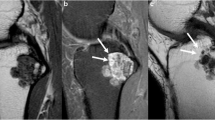Abstract
Objective
Osteochondromas are the most common benign bone tumors, and thus far, their spontaneous shrinkage is considered a rare phenomenon. This study was designed to investigate the exact ratio of remission to progressive or stable cases and analyze the mechanism of tumor regression on the basis of existing theories.
Materials and methods
We retrospectively collected images of solitary osteochondromas in patients from 1992 to 2013, excluding cases involving short-term follow-up periods and follow-up periods that ended before growth plate closure. A total of 121 patients were diagnosed and screened for study inclusion. Tumor shrinkage was measured by assessing three points on tumor contours to determine if they had regressed or vanished. Patterns of shrinkage were further divided on the basis of mechanisms described as incorporation, absorption, and fracture.
Results
Seventeen patients (mean age at initial diagnosis 13.1 years) met the study inclusion criteria. Tumor morphological classifications were pedunculated (10 cases) and sessile (7 cases). Osteochondroma shrinkage was the most common outcome (8 cases), followed by stable osteochondromas (6 cases), and osteochondromas that had progressed (3 cases). Tumors with sessile morphology were more prone to shrinkage (6 of 7 cases) compared with those of pedunculated morphology (2 of 10 cases; p = 0.015). Among pedunculated cases, tumor shrinkage was via absorption. The timing of tumor growth cessation was related to the pattern of tumor shrinkage. Absorption mostly followed tumor growth cessation, whereas incorporation mostly preceded tumor growth cessation.
Conclusion
The shrinkage of osteochondromas appears less rare than was originally thought.








Similar content being viewed by others
References
Dorfman HD, Czerniak B. Bone tumors, 2nd edn. St Louis, MO: Mosby Inc.; 1998. p. 331–3.
Altay M, Bayrakci K, Yildiz Y, Erekul S, Saglik Y. Secondary chondrosarcoma in cartilage bone tumors: report of 32 patients. J Orthop Sci. 2007;12:415–23.
Hoshi M, Takami M, Hashimoto R, Okamoto T, Yanagida I, Matsumura A, et al. Spontaneous regression of osteochondromas. Skelet Radiol. 2007;36:531–4.
Paling MR. The “disappearing” osteochondroma. Skelet Radiol. 1983;10:40–2.
Copeland RL, Meehan PL, Morrissy RT. Spontaneous regression of osteochondromas: two case reports. J Bone Joint Surg Am. 1985;67:971–3.
Castriota-Scanderbeg A, Bonetti MG, Cammisa M, Dallapiccola B. Spontaneous regression of exostoses: two case reports. Pediatr Radiol. 1995;25:544–8.
Sellink JL. Spontaneous regression of an exostosis. J Belg Radiol. 1960;43:177–9.
Callan JE, Wood VE, Linda L. Spontaneous resolution of an osteochondroma. J Bone Joint Surg Am. 1975;57:723.
Merle P, Rougier JL, Duclos AM, Gras JC. Evanescent exostosis: a report on one case. J Radiol. 1980;61:291–2. [In French]
Rosa MA, Cianfanelli M. Evolutionary behavior of an osteochondroma: spontaneous regression. Arch Putti Chir Organi Mov. 1985;35:373–6. [In Italian]
Montgomery DM, LaMont RL. Resolving solitary osteochondromas: a report of two cases and literature review. Orthopedics. 1989;12:861–3.
Revilla Y, Lozano MC, González G, Martínez A. Evanescent exostosis: a new case. Eur J Radiol. 1999;29:270–2.
Yamamoto T, Kurosaka M, Mizuno K. Spontaneous resolution of a phalangeal solitary osteochondroma. J Hand Surg Am. 2001;26:556–8.
Yanagawa T, Watanabe H, Shinozaki T, Ahmed AR, Shirakura K, Takagishi K. The natural history of disappearing bone tumours and tumour-like conditions. Clin Radiol. 2001;56(11):877–86.
Reston SC, Savva N, Richards RH. Spontaneous resolution of solitary osteochondroma in the young adult. Skelet Radiol. 2004;33:303–5.
Choi JY, Hong SH, Kim HS, Chang CB, Lee YJ, Kang HS. Resorption of osteochondroma by accompanying pseudoaneurysm. ARJ Am J Roentgenol. 2005;185:394–6.
Arkader A, Dormans JP, Gaugler R, Davidson RS. Spontaneous regression of solitary osteochondroma: reconsidering our approach. Clin Orthop Relat Res. 2007;460:253–7.
Minami S, Nakatani N, Miyazaki N, Watanuki A, Honda T, Yoshida M. Spontaneous regression of a solitary osteochondroma of the distal tibia. J Orthop Sci. 2009;14:669–71.
Valdivielso-Ortiz A, Barber I, Soldado F, Aguirre-Canyadell M, Enriquez G. Solitary osteochondroma: spontaneous regression. Pediatr Radiol. 2010;40:1699–701.
Mahmoodi SM, Bahirwani RK, Moosa NK, Eydou AZ, AbdullGaffar B. Spontaneous osteochondroma resolution in a young female: imaging and histopathological findings. Med Princ Pract. 2010;19:228–31.
Stitzman-Wengrowicz ML, Pretell-Mazzini J, Dormans JP, Davidson RS. Regression of a sessile osteochondroma: a case study and review of the literature. UPOJ. 2011;21:73–6.
Passanise AM, Mehlman CT, Wall EJ, Dieterle JP. Radiographic evidence of regression of a solitary osteochondroma: a report of 4 cases and a literature review. J Pediatr Orthop. 2011;31:312–6.
Deprez FC, Beltrán-Marín M, Malghem J, Menten R, Clapuyt R. Solitary osteochondroma: spontaneous regression. JBR-BTR. 2011;94:217.
Hill CE, Boyce L, van der Ploeg ID. Spontaneous resolution of a solitary osteochondroma of the distal femur: a case report and review of the literature. J Pediatr Orthop B. 2014;23:73–5.
Nora FE, Dahlin DC, Beabout JW. Bizarre parosteal osteochondromatous proliferations of the hands and feet. Am J Surg Pathol. 1983;7:245–50.
Horvai A, Unni KK. Premalignant conditions of bone. J Orthop Sci. 2006;11:412–23.
Richardson RR. Variants of exostosis of the bone in children. Semin Roentgenol. 2005;40:380–90.
Acknowledgements
We thank all participating patients and the physicians who initially invited the patients to participate in this study. Also, we thank Shingo Shimozaki (Nanto Chuo hospital) who endeavored to correcting case reports of spontaneous regression of solitary osteochondroma.
Author information
Authors and Affiliations
Corresponding author
Ethics declarations
Conflict of interest
The authors declare that they have no conflict of interest.
Ethical approval
All procedures performed in studies involving human participants were in accordance with the ethical standards of the institutional and/or national research committee and with the 1964 Helsinki declaration and its later amendments or comparable ethical standards.
Rights and permissions
About this article
Cite this article
Aiba, H., Yamada, S., Yamamoto, N. et al. Spontaneous shrinkage of solitary osteochondromas. Skeletal Radiol 47, 61–68 (2018). https://doi.org/10.1007/s00256-017-2760-0
Received:
Revised:
Accepted:
Published:
Issue Date:
DOI: https://doi.org/10.1007/s00256-017-2760-0




